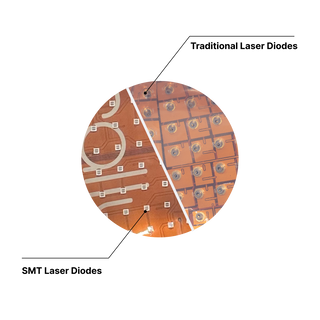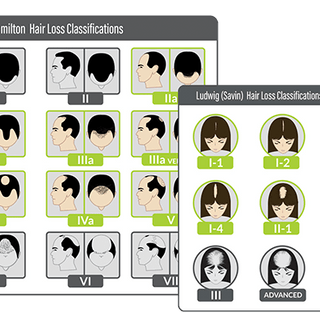Androgenetic alopecia, also known as male or female pattern baldness, is a genetic condition characterized by progressive hair loss primarily from the scalp. In this condition, hair follicles shrink over time, leading to shorter and finer hair strands. Eventually, the affected follicles may stop producing hair altogether.

|

|
|
Healthy Follicles:
|
Follicles with AGA:
|
Here's a more detailed explanation of what happens to hair in androgenetic alopecia:
-
Miniaturization of Hair Follicles: Androgenetic alopecia is primarily driven by the effects of dihydrotestosterone (DHT), a derivative of testosterone, on hair follicles that are susceptible due to a hereditary, genetic predisposition. DHT binds to androgen receptors on hair follicles, leading to their miniaturization, meaning the affected follicles become smaller in size over time.
-
Shortened Anagen Phase: The anagen phase is the active growth phase of the hair cycle. In androgenetic alopecia, the anagen phase becomes progressively shorter, leading to shorter hair strands with each successive growth cycle. Eventually, the anagen phase may become so short that affected follicles produce only very fine, barely visible hair.
-
Telogen Phase: Following the shortened anagen phase, affected hair follicles enter the telogen (resting) phase prematurely. This results in a shorter overall hair cycle, with less time spent actively growing hair.
-
Decreased Hair Density: As more and more follicles miniaturize and enter shorter growth cycles, the overall density of hair on the scalp decreases. This leads to the appearance of thinning hair, which may progress to partial or complete baldness in certain areas of the scalp.
-
Progressive Nature: Androgenetic alopecia typically progresses gradually over time. It often starts with a receding hairline in men or thinning at the crown of the scalp in both men and women. Eventually, the hair loss may spread to other areas of the scalp, leading to more extensive baldness.
-
Pattern of Hair Loss: The pattern of hair loss in androgenetic alopecia follows a characteristic distribution, with certain areas of the scalp being more susceptible to DHT-induced miniaturization. In men, this often results in a "M" shape pattern of hair loss, while in women, it tends to cause diffuse thinning throughout the scalp.
Overall, androgenetic alopecia is a chronic, progressive condition that affects the hair follicles, leading to gradual hair loss and thinning over time.






